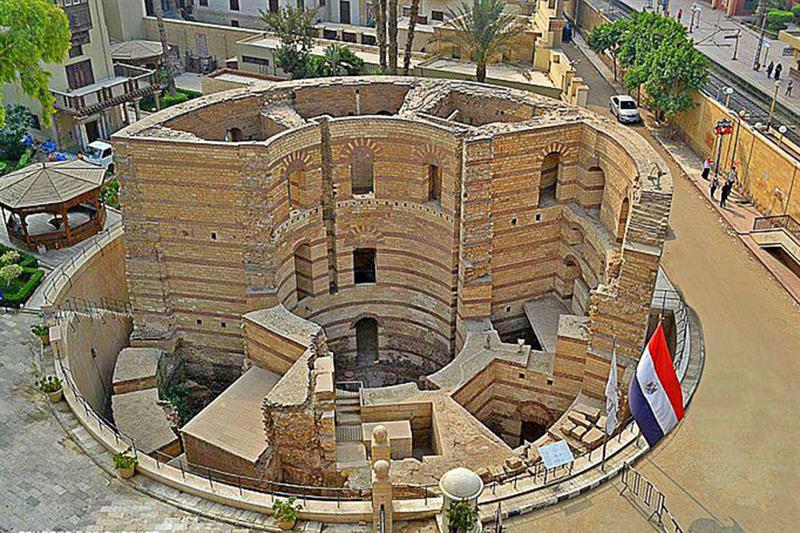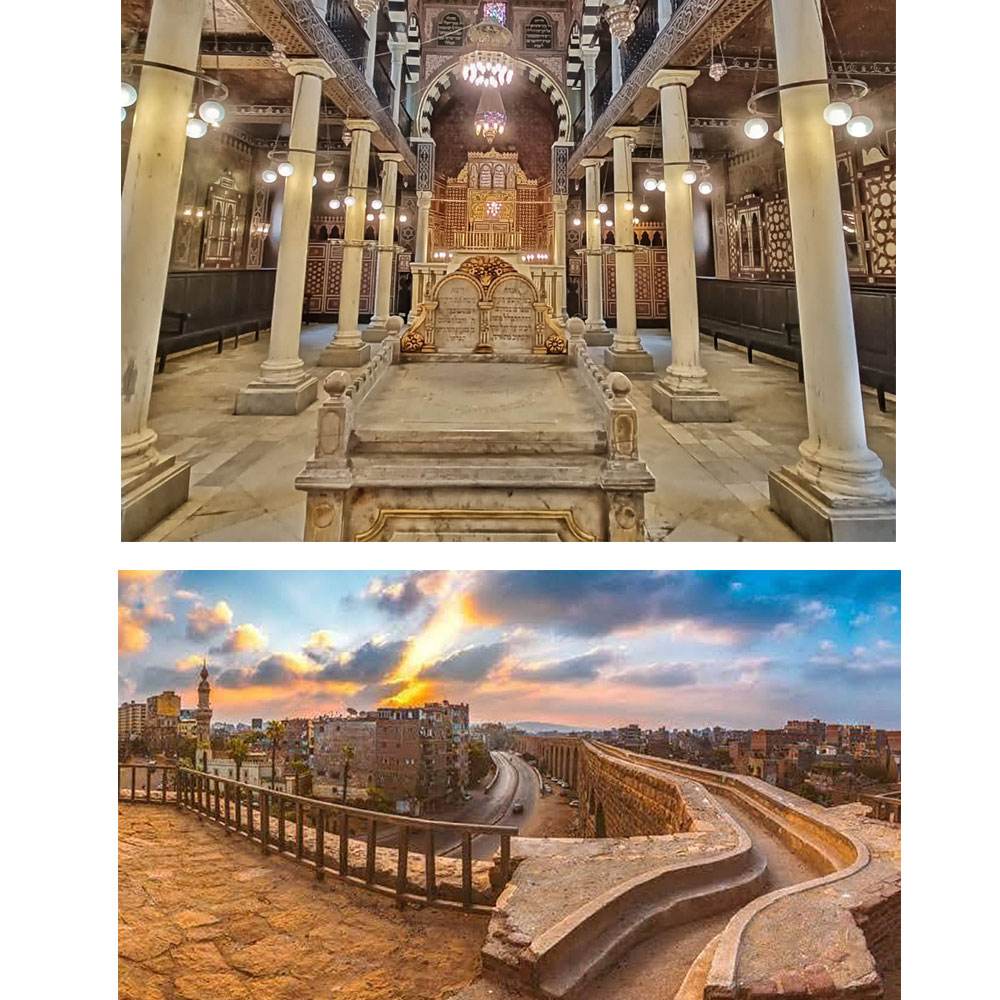Three sites renovated in Old Cairo
Nevine El-Aref , Tuesday 23 May 2023
After almost a decade of restoration, the Ben Ezra Synagogue, the Aqueduct, and the Babylon Fortress in Old Cairo have regained something of their original allure, reports Nevine El-Aref

Historic Cairo, with its famous mosques, madrassas (schools), sabil-kuttab (water fountains and Quranic schools), hammams (bathhouses) and wekalas (trade centres), is one of the oldest mediaeval cities in the world. Since 1979, it has been registered on the UN cultural agency UNESCO's World Heritage List.
In the early 2000s, a project to restore and rehabilitate its monuments was launched in an attempt to rescue them not only for their historical and archaeological value, but also to restore their role in the community through halting deterioration, removing debris, and developing the sites and their surroundings and transforming the whole area into an open-air museum.
Many Islamic, Coptic, and Jewish monuments in the area have now been restored, and in 2016 another campaign was launched to restore 100 monuments in the area and develop the skills of workers in the field of restoration through direct participation, as well as to provide investment opportunities to rehabilitate ancient buildings.
The Ben Ezra Synagogue, the Aqueduct, and the Babylon Fortress in Old Cairo are now reaching the final stages of their restoration and will be officially inaugurated soon as part of plans to preserve and revive the ancient city of Fustat that once stood in the area.
The three monuments, like others in heavily populated areas, were suffering from environmental dangers including air pollution, high subsoil-water levels, high levels of humidity and water leakage, and the effects of a decayed sewage system installed 100 years ago. There were also the adverse effects of the 1992 earthquake that increased the number of cracks in their walls.
The walls of the buildings have now been reinforced and cleaned as part of the restoration project, and the masonry cleaned and desalinated. Decayed parts of the wooden mashrabiya windows have been restored and replaced with similar ones. Wooden ceilings and decorative elements have also been restored and paintings retouched.
New lighting system have been installed in the three buildings, giving them a dramatic look. The restoration work had been carried out according to the latest methods, and every effort had been made to ensure that all original architectural features have been retained.
"The three monuments have now regained their original allure, announcing new attractions and the government's desire to restore and preserve the country's heritage not only for Egyptians but also for all humanity," Mustafa Waziri, secretary-general of the Supreme Council of Antiquities (SCA), said.

BEN EZRA SYNAGOGUE: The synagogue is named after the Jewish religious scholar and philosopher Abraham Ibn Ezra and stands next to the Coptic Museum, the Amr Ibn Al-Aas Mosque, and the Hanging and St Sergius and Bacchus churches in the religious compound in Old Cairo.
More than three decades after its last restoration, the synagogue has been restored again to remove the marks of time on its walls, ceilings, and decorations.
Abu Bakr Ahmed, head of the Islamic, Coptic, and Jewish Antiquities Sector at the Ministry of Antiquities, said that the Ben Ezra Synagogue was originally a church known as the Al-Shammaain Church that the Egyptian Coptic Orthodox Church sold in 882 CE to the Jewish community.
It is said that the Ben Ezra Synagogue marks the site where Moses prayed for the lifting of the plague that afflicted the ancient Egyptians that is mentioned in the Old Testament of the Bible. It was built in the basilical style, meaning that it is composed of three halls, the middle being the largest and tallest.
The central hall of the synagogue is surmounted by an octagonal dome. The sanctuary is on the east wall, which is also where the Torah case, made of wood inlaid with pearl and ivory, is located. A few steps lead up to the marble pulpit, which lies at the centre of the synagogue.
The upper level is reserved for women and overlooks the prayer area. On its north side is the geniza, which was sealed and could only be reached through an aperture in its roof.
Every synagogue has a geniza, being a repository for old documents mentioning the name of God. Since it was impermissible to throw away texts or documents bearing the name of God, these were all once kept in genizas. The Ben Ezra Synagogue's geniza was discovered in 1896, and its mediaeval and later contents were moved to the University of Cambridge in the UK for study and research.
THE AQUEDUCT OF MAGRA AL-OYOUN was built by Al-Nasser Salaheddin Al-Ayoubi (Saladin) and was renovated during the reign of the later Mameluke Sultan Al-Nasr Mohamed Ibn Qalawoun. Sultan Qunsur Al-Ghuri built the aqueduct's water wheels. It extends from the banks of the Nile to Sayeda Aisha Square close to the citadel.
Hisham Samir, assistant to the tourism and antiquities minister for antiquities projects, said that the wooden waterwheels on top of the building had been fixed and maintained as part of the restoration work and all encroachments on the walls and the surrounding area removed. The stonework had been cleaned and dirt and soot removed.
The woodwork and floors in the internal corridors have been restored, the stairs rehabilitated, and the area surrounding the monument upgraded.
The idea of building an aqueduct to carry water to the citadel goes back to the reign of Salaheddin Al-Ayoubi himself. A canal was dug on top of the wall to convey water to the citadel by a series of waterwheels from a well. The water flowed through the canal to the citadel, where it was used for drinking and the irrigation of the surrounding areas.
During the Mameluke period when the population of the citadel expanded, Sultan Al-Nasr Mohamed Ibn Qalawoun constructed a tower that contained four waterwheels on the banks of the Nile to increase the water flow to the citadel.
These waterwheels raised water up to a canal system located on top of a series of raised arches that were supported by large stone piers. The structure was designed to form a slope in order that it would connect with the earlier Aqueduct.
Ahmed said that during the rule of the Mameluke Sultan Qaitbay, major renovation work to the aqueduct was undertaken as well as during the period of Sultan Qunsor Al-Ghuri when further restoration was done and the waterwheel tower renovated.
The water system was developed, and the water was pooled in the square at the foot of the citadel before being raised by waterwheels to cisterns inside. The aqueduct was functional until the Ottoman period, but felt into disuse during the French expedition under the leadership of Napoleon Bonaparte at the end of the 18th century, as the French soldiers blocked some of the arches and transformed them into fortifications.
The remaining section of the aqueduct is considered one of the most beautiful examples of such architecture in the entire Islamic world.
BABYLON FORTRESS: The southern section of the Babylon Fortress located beneath the Hanging Church and known as the Amr Gate has been restored after the completion of the first phase near the Coptic Museum in Old Cairo.
Samir said that the façadeof the fortress's southern part have been cleaned of dust and bird droppings and damaged blocks restored. A new lighting system has also been installed to highlight the beauty of the architecture and the original job for which it was constructed.
During the second century CE, the Roman emperor Trajan ordered the construction of a fortress to secure the Roman military and to be the first line of defence at the eastern gateway of Egypt. In the fourth century CE, the Roman emperor Arcadius restored, expanded, and strengthened the fortress.
According to Coptic scholar Morkos Semeka Pasha, the history of the Babylon Fortress extended until the Islamic conquest. When Amr Ibn Al-Aas conquered Egypt in the seventh century CE, the fortress fell into his hands after seven months of siege.
* A version of this article appears in print in the 25 May, 2023 edition of Al-Ahram Weekly
-- Sent from my Linux system.
No comments:
Post a Comment